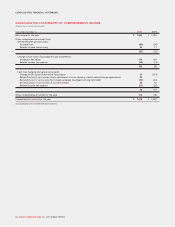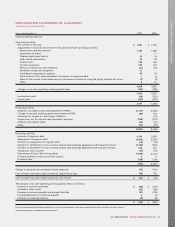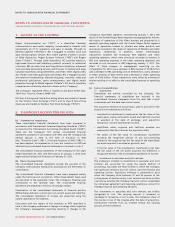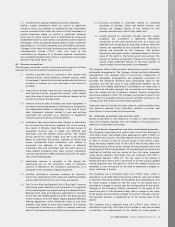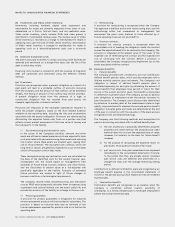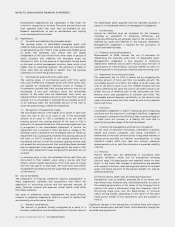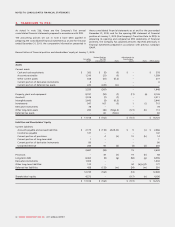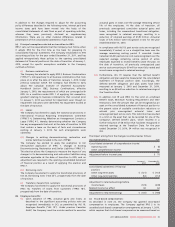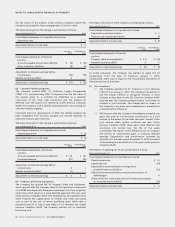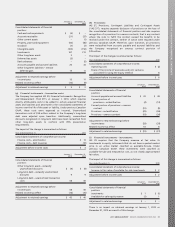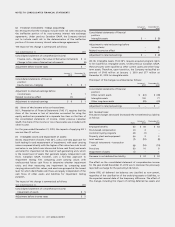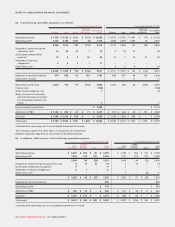Rogers 2011 Annual Report Download - page 94
Download and view the complete annual report
Please find page 94 of the 2011 Rogers annual report below. You can navigate through the pages in the report by either clicking on the pages listed below, or by using the keyword search tool below to find specific information within the annual report.
NOTES TO CONSOLIDATED FINANCIAL STATEMENTS
Development expenditures are capitalized if they meet the
criteria for recognition as an asset. The assets are amortized over
their expected useful lives once they are available for use.
Research expenditures, as well as maintenance and training
costs, are expensed as incurred.
(r) Impairment:
(i) Goodwill and indefinite-life intangible assets:
The carrying values of identifiable intangible assets with
indefinite lives and goodwill are tested annually for impairment.
A cash generating unit (“CGU”) is the smallest identifiable group
of assets that generates cash inflows that are largely
independent of the cash inflows from other assets or groups of
assets. Goodwill and indefinite life intangible assets are
allocated to CGUs for the purpose of impairment testing based
on the level at which management monitors them, which is not
higher than an operating segment. The allocation is made to
those CGUs that are expected to benefit from the business
combination in which the goodwill arose.
(ii) Non-financial assets with finite useful lives:
The carrying values of non-financial assets with finite useful
lives, such as PP&E and intangible assets with finite useful lives,
are assessed for impairment whenever events or changes in
circumstances indicate that their carrying amounts may not be
recoverable. If any such indication exists, the recoverable
amount of the asset must be determined. Such assets are
impaired if their recoverable amount is lower than their carrying
amount. If it is not possible to estimate the recoverable amount
of an individual asset, the recoverable amount of the CGU to
which the asset belongs is tested for impairment.
(iii) Recognition of impairment charge:
The recoverable amount is the higher of an asset’s or CGU’s fair
value less costs to sell or its value in use. If the recoverable
amount of an asset or CGU is estimated to be less than its
carrying amount, the carrying amount of the asset or CGU is
reduced to its recoverable amount. The resulting impairment loss
is recognized in the consolidated statements of income. An
impairment loss is reversed if there has been a change in the
estimates used to determine the recoverable amount. When an
impairment loss is subsequently reversed, the carrying amount of
the asset or CGU is increased to the revised estimate of its
recoverable amount so that the increased carrying amount does
not exceed the carrying amount that would have been recorded
had no impairment losses been recognized for the asset or CGU
in prior years. Impairment losses recognized for goodwill are not
reversed.
In assessing value in use, the estimated future cash flows are
discounted to their present value using a pre-tax rate that
reflects current market assessments of the time value of money
and the risks specific to that asset. The cash flows used reflect
management assumptions and are supported by external sources
of information.
(s) Use of estimates:
The preparation of financial statements requires management to
make judgements, estimates and assumptions that affect the
application of accounting policies and the reported amounts of
assets, liabilities, revenue and expenses. Actual results could differ
from these estimates.
Key areas of estimation, where management has made difficult,
complex or subjective judgements, often as a result of matters that
are inherently uncertain are as follows:
(i) Business combinations:
The amount of goodwill initially recognized as a result of a
business combination and the determination of the fair value of
the identifiable assets acquired and the liabilities assumed is
based, to a considerable extent, on management’s judgement.
(ii) Income taxes:
Income tax liabilities must be estimated for the Company,
including an assessment of temporary differences. Any
temporary differences will generally result in the recognition of
deferred tax assets and liabilities in the financial statements.
Management’s judgement is required for the calculation of
current and deferred taxes.
(iii) Property, plant and equipment:
Measurement of PP&E involves the use of estimates for
determining the expected useful lives of depreciable assets.
Management’s judgement is also required to determine
depreciation methods and an asset’s residual value, the rate of
capitalization of internal labour costs and whether an asset is a
qualifying asset for the purposes of capitalizing borrowing costs.
(iv) Impairment of non-financial assets:
The impairment test on CGUs is carried out by comparing the
carrying amount of CGUs and their recoverable amount. The
recoverable amount of a CGU is the higher of its fair value, less
costs to sell and its value in use. This complex valuation process
used to determine fair value less costs to sell and/or value in use
entails the use of methods such as the discounted cash flow
method which uses assumptions to estimate cash flows. The
recoverable amount depends significantly on the discount rate
used in the discounted cash flow model as well as the expected
future cash flows.
(v) Provisions:
Considerable judgement is used in measuring and recognizing
provisions and the exposure to contingent liabilities. Judgement
is necessary to determine the likelihood that a pending litigation
or other claim will succeed, or a liability will arise and to
quantify the possible range of the final settlement.
(vi) Financial risk management and financial instruments:
The fair value of derivative instruments, investments in publicly
traded and private companies, and equity instruments is
determined on the basis of either prices in regulated markets or
quoted prices provided by financial counterparties, or using
valuation models which also take into account subjective
measurements such as, cash flow estimates or expected volatility
of prices.
(vii) Pensions:
Pension benefit costs are determined in accordance with
actuarial valuations, which rely on assumptions including
discount rates, life expectancies and expected return on plan
assets. In the event that changes in assumptions are required
with respect to discount rates and expected returns on invested
assets, the future amounts of the pension benefit cost may be
affected materially.
(viii) Stock options, share units and share purchase plans:
Assumptions, such as volatility, expected life of an award, risk-
free interest rate, forfeiture rate, and dividend yield, are used in
the underlying calculation of fair values of the Company’s stock
options. Fair value is determined using the Company’s Class B
Non-Voting share price, and the Black-Scholes or trinomial
option pricing models, depending on the nature of the share
based award. Details of the assumptions used are included in
note 22.
Significant changes in the assumptions, including those with respect
to future business plans and cash flows, could materially change the
recorded carrying amounts.
90 ROGERS COMMUNICATIONS INC. 2011 ANNUAL REPORT


